|
|
 |
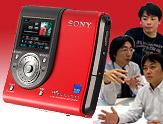 |
|
The challenge to implement the new standard, the Hi-MD Photo
Q:
This is the new Hi-MD [MZ-DH10P/R] but it corresponds to a new standard, the Hi-
MD Photo, is that correct? Could you please elaborate on this new standard?
A [Product planner, Hirasawa]: Actually, the concept of Hi-MD Photo originated from the birth of MD in 1992 and was discussed in the interview-article about ``the introduction of Hi-MD Audio.'' But the idea truly reached its zenith in July 2004 with the advent of Hi-MD. The advent of Hi-MD simply provides the foundation for the conception of implementing image storage-recording capability for this format. The new Hi-MD Photo, which evolved from MD to Hi-MD, has been an exclusive music format since its inception. Now it functions as a general purpose media which can also record images with Hi-MD independent from the computer. Hi-MD Photo also conforms to the DCF/Exif standard, which is the de facto standard of the recording mode for digital camera. Additionally, images recorded in the Hi-MD media can be shared with other devices such as digital cameras and printers.
In addition, because Hi-MD Photo maintains the thumbnail format to view images, this
indicates that one can search or view music information by scrolling thru album jackets.
Furthermore, the combined functions of Hi-MD Photo — music and picture — can allow further possibilities. For example, usage of album jackets, photographing lyric cards, scenery and etc [*]. Since, this is the first MD device that adopts the idea of ``Digital Music Visual Player'' you can imagine the possibility of enjoying music in different methods.
* while playing back music, photography is not possible.
|
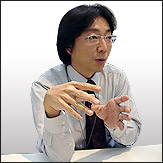 Akira Tanaka [Designer]
Sony Corporation Information Technogy and Communications Network Company Personal Communications Business Section. MZ-DH10P Design Project Leader 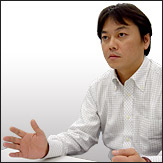 Tsutomu Hirasawa Sony Corporation Personal Audio Visual Network Company. Personal Audio Business Headquarters Marketing Strategic Section |
|
Justification for its size and design: MZ-DH10P in retrospect to its predecessor.
Q The advent of Hi-MD Photo has expanded the world of Hi-MD Walkman. However,
wouldn't you agree that by implementing image and photo capability, this idea have
increased the size of the unit? A [The designer, Soichi Tanaka]: There is a prevalent prejudice in maintaining existing size of the MD Walkman due to standards set by its predecessors. The MZDH10P unit that I could show at the end of 2003 was still a prototype with a 3 mega pixels camera then considered as a prerequisite. When you employ a higher mega pixels camera module, the size of the unit inevitably increases - thus, the tremendous size in comparison to existing MD Walkman. Although the concept of this new MD Walkman has the ability to take pictures it is not a digital camera, so to speak. In addition, the notion that MD Walkman being a digital camera is not welcomed. So when it does, ``you will be appointed by the design project leader'' with the responsibility to reduce its size. (S. Tanaka laughing) Q: So, what did you do to enable reduction in size? A [The designer, Soichi Tanaka]: Typically, MD Walkman's electronic circuits and chips are placed or installed if you will on both sides of the base plates. Thus, the additional camera module for the MZ-DH10P requires advanced circuitry, which led to the one base plate being divided into 2 for the camera module with existing MD circuits and chips. The placement of advance circuitry within the base plates nevertheless ``is still thick and needs to be marginally thinner'' (S. Tanaka laughing). However, because both of the two base plates were used with no quarter spared, the unit will inevitably become thicker. While a variety of designs were examined, at the end the camera module was only mounted on one side of the base plate so that our aim to attain a slim unit will be realized.
The drawing process of the blueprint was very repetitious. The contour of the unit had to
be redrawn one after another just to achieve the best arch appearance for the unit.
|
 Soichi Tanaka [Designer]
SONY corporation design center PCD MZ-DH10P Designer 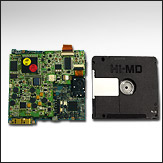 MD media and 'DH10P' size relative picture of baseplate |
|
Music + Picture = The embodiment of a new concept and design.
Q
This model bears a soft rectilinear line with a distinct shape. When did you conceive
the idea of arch shape?
A [The Project Design Leader, Akira Tanaka]: It was in January, 2004 that a conceptual design of this model was born. So, the arch shape of the unit was conceived since the beginning. Indeed, the rectilinear design also facilitates the development of an internal design that is structurally viable.
The rationale for the arch shape revolves around the implementation of the ability to take
photographs with the unit. Because this model now operates beyond the conventional use
of the remote with MD, the need for this model to be user friendly when the photography
option is used is crucial. Therefore, you can imagine the need of an ergonomic form so
that it is useable with the hand. The arch shape allows the hand to fit ergonomically with
the unit when the user is taking pictures. And, if I had designed the unit by adjusting the
height of the camera module to match the color liquid crystal (OLED) area, the unit itself
will look much fatter (A. Tanaka laughing). Therefore, the rectilinear design was
necessary.
This time, the OLED screen was utilized and installed onto the housing of the new model. Because the new OLED screen will be mainly used for navigation of music database, the black color scheme of the band was thought to be ideal. The rationale behind the dark color band around the OLED is to provide a cleaner contrast when navigating between music databases and enhance the experience when viewing jacket photographs.
In addition, to express the concept of Walkman + picture, the music and picture aspect
were seamlessly connected within the black band. The black band has a functional aspect
aside its aesthetic feature. A portion of the black band serves as a lens cap for the camera
module. Moreover, when one opens the lens cap, the unit switches automatically to
camera mode. So, the lens cap in essence accentuates the presence of the camera module
otherwise not distinct on the surface of the unit.
|
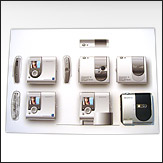 Early design concept of 2004 model. Camera position and the like
are subtly different, but the design concept is nearly the same as the finished product
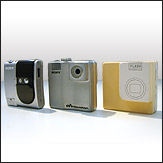
Progression from mock-up to finished product |
|
We would like our customer to enjoy the new world of music.
Q
Finally, what message would you like to leave for the consumers?
A [Product planner, Hirasawa]: The MZ-DH10P Walkman is something which had evolved from just a unit that enjoys music to include the ability to view pictures. This evolution begins with the advent of music transfer via the use the personal computer, which now has expanded to include the ability to transfer and set pictures as the jacket of the album via SonicStage. Additionally, music purchased through the online music store, Mora will include jacket picture automatically. Since the unit now incorporates the ability to utilize music and picture, we would like you to maximize the use of music and picture with the new Walkman. A [The designer, Soichi Tanaka]: The functionality of the unit is uncomplicated and its respective operative buttons around the new UI of the OLED only requires minimum learning curve. This new advancement of the MZ-DH10P's UI was made possible by the current external flash memory. But of course, new revision of the firmware will be available even though I think that the current version already provides an UI that is relatively easy to use with the MD.
While navigating thru the music database with the MZ-DH10P, you get to enjoy album
jackets by using the slide show option since the new Hi-MD Photo utilizes music and
picture. Another great thing about this Hi-MD Walkman is that you can also show and
share your pictures taken with the Hi-MD Walkman with friends (slide shows). Another
aim of the MZ-DH10P is that it aims to appeal to the female users as much as it appeals
to the male users by the combination of music and pictures.
|